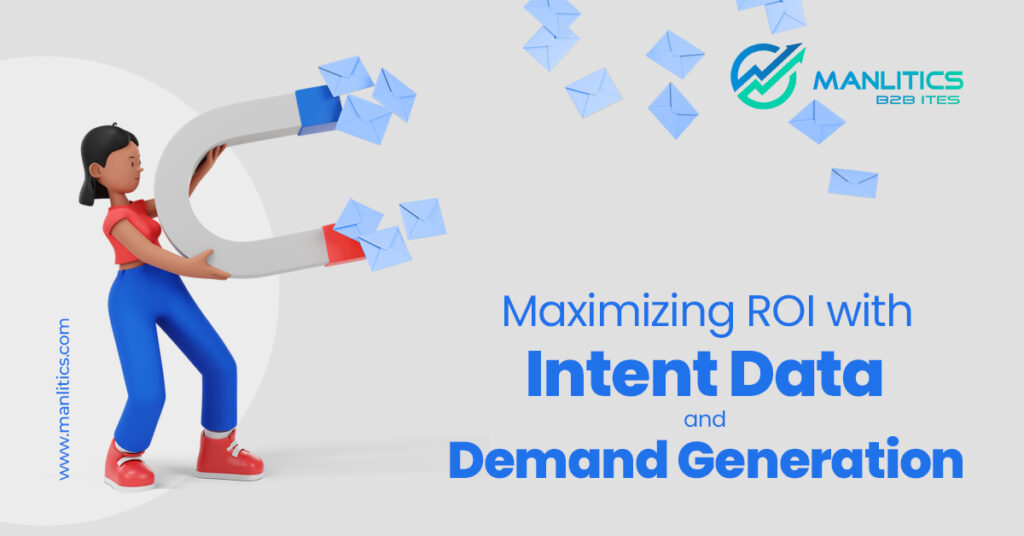Maximizing ROI with Intent Data and Demand Generation

Maximizing ROI with Intent Data and Demand Generation
Intent data and demand generation are two key components of a successful marketing strategy, and when used together, they can help your company achieve a high return on investment (ROI). In this blog, we’ll explore what intent data and demand generation are, how they can be used to maximize ROI, and best practices for integrating them into your marketing efforts.
What is intent data?
Intent data refers to information about a person’s online behavior that indicates their interests or intent to purchase. This can include website visits, searches, social media interactions, and content downloads. By tracking this data, companies can gain a better understanding of what potential customers are interested in and tailor their marketing efforts accordingly.
What is demand generation?
Demand generation is the process of attracting and converting potential customers through a variety of marketing efforts. This can include inbound marketing, content marketing, email marketing, social media marketing, event marketing, and more. The goal of demand generation is to create demand for a company’s products or services and generate leads that can be nurtured into paying customers.
How can intent data and demand generation be used to maximize ROI?
Intent data and demand generation can be used together to create a more targeted and personalized marketing strategy. By using intent data to understand what potential customers are interested in, companies can create demand generation campaigns that are more likely to resonant with their target audience. This can result in higher conversion rates and a higher ROI.
For example, let’s say a company sells software for small businesses. Using intent data, the company can identify individuals who have recently visited websites related to small business software or searched for terms related to the software. They can then create a demand generation campaign targeting these individuals with personalized emails or ads that showcase the benefits of their software and how it can solve specific problems faced by small businesses. This targeted approach is more likely to result in conversions than a generic campaign that is not tailored to the needs and interests of the target audience.
Best practices for integrating intent data and demand generation
Here are some best practices for integrating intent data and demand generation:
1. Use intent data to segment your audience: By segmenting your audience based on their intent data, you can create more targeted and personalized demand generation campaigns.
2. Integrate intent data into your lead nurturing efforts: Use intent data to understand where potential customers are in the sales funnel and tailor your lead nurturing efforts accordingly.
3. Monitor and track the performance of your campaigns: Use tools like Google Analytics or a marketing automation platform to track the performance of your demand generation campaigns and see how they are impacting your ROI.
4. Continually test and optimize: Don’t be afraid to experiment with different demand generation strategies and see what works best for your company. Use intent data and performance tracking to continually optimize your campaigns and improve your ROI.
Conclusion:
Intent data and demand generation are powerful tools that can help your company maximize its ROI. By using intent data to create targeted and personalized demand generation campaigns, you can attract and convert more potential customers and drive sales. By following best practices and continually testing and optimizing your efforts, you can continue to improve your ROI over time.
How to Find Your Target Audience’s Intent With Intent Data

How to Find Your Target Audience's Intent With Intent Data
Target audience’s intent: In today’s digital age, businesses have access to an abundance of data that can help them make better decisions. One type of data that is particularly useful for marketers is intent data.
Intent data is information that provides insight into the behavior and interests of potential customers. By analyzing intent data, businesses can gain a better understanding of their target audience’s needs and preferences, and tailor their marketing strategies accordingly.
But what exactly is intent data, and how can you use it to find your target audience’s intent? In this blog post, we’ll answer these questions and more.
What is Intent Data?
Intent data is information that provides insight into the behavior and interests of potential customers. This information can be collected from a variety of sources, including website analytics, social media monitoring, and customer relationship management (CRM) systems.
There are two main types of intent data: explicit and implicit. Explicit intent data is information that customers provide directly, such as filling out a contact form or downloading a whitepaper. Implicit intent data, on the other hand, is information that is inferred from a customer’s behavior, such as their browsing history or social media activity.
Why is Intent Data Important?
Intent data is important because it allows businesses to gain a better understanding of their target audience’s needs and preferences. By analyzing this data, businesses can identify patterns and trends in customer behavior, which can help them create more targeted and effective marketing campaigns.
For example, if a business knows that a particular group of customers is searching for a specific product or service, they can create content that addresses the questions and concerns that these customers have. This can help the business attract more qualified leads and increase their chances of converting them into customers.
How to Use Intent Data to Discover Your Target Audience’s Intent:
Now that we’ve covered what intent data is and why it’s important, let’s look at how you can use intent data to find your target audience’s intent.
Use Website Analytics:
Website analytics can provide valuable insight into your target audience’s behavior and interests. By tracking metrics such as page views, bounce rate, and time on site, you can gain a better understanding of which pages and topics are most popular among your target audience.
You can also use website analytics to identify which keywords and search terms are driving traffic to your site. This information can help you create content that is optimized for these keywords and topics, which can help you attract more qualified leads.
Monitor Social Media:
Social media monitoring can also provide valuable insight into your target audience’s behavior and interests. By monitoring social media conversations and mentions of your brand, you can gain a better understanding of how your target audience perceives your brand and what they are interested in.
You can also use social media monitoring to identify trending topics and conversations that are relevant to your brand. By participating in these conversations and sharing content that is relevant to these topics, you can increase your brand’s visibility and attract more qualified leads.
Use Customer Relationship Management (CRM) Systems:
Customer Relationship Management (CRM) systems can provide valuable insight into your target audience’s behavior and interests. By tracking customer interactions and behavior, you can gain a better understanding of which products and services are most popular among your target audience.
You can also use CRM systems to identify patterns and trends in customer behavior, such as which customers are most likely to purchase a particular product or service. This information can help you create targeted marketing campaigns that are more likely to resonate with your target audience.
Use Intent Data Platforms:
Intent data platforms are tools that use machine learning algorithms to analyze customer behavior and provide insight into their intent. These platforms can provide valuable insight into which topics and products are most relevant to your target audience, and which customers are most likely to purchase your products or services
In conclusion:
intent data is a valuable tool for businesses looking to understand their target audience’s needs and preferences. By analyzing intent data from various sources such as website analytics, social media monitoring, CRM systems, and intent data platforms, businesses can create more targeted and effective marketing campaigns that resonate with their target audience.
Understanding your target audience’s intent can help you attract more qualified leads, increase conversions, and ultimately, grow your business. Therefore, incorporating intent data into your marketing strategy can help you stay ahead of the competition and better serve your customers.




